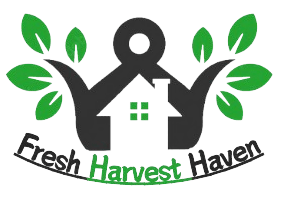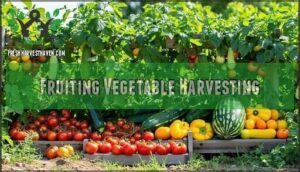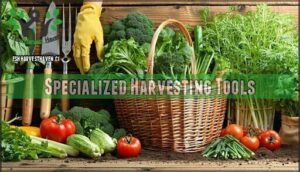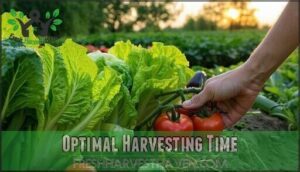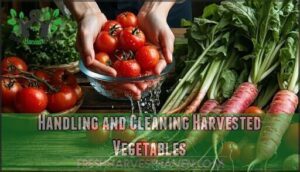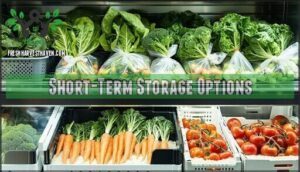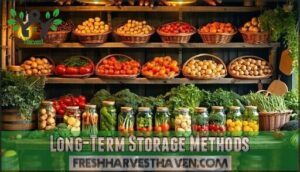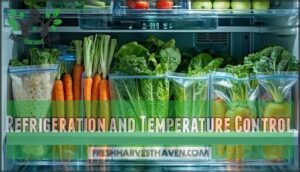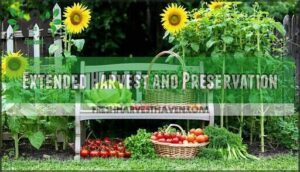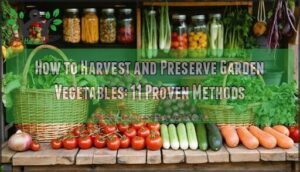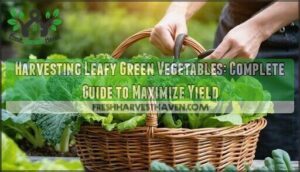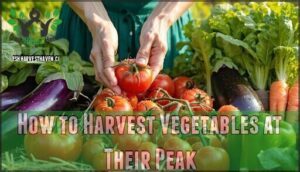This site is supported by our readers. We may earn a commission, at no cost to you, if you purchase through links.
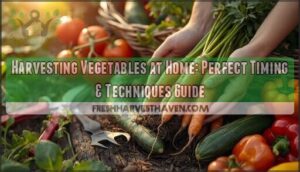 Mastering harvesting vegetables at home means watching for key ripeness signals and timing your picks perfectly.
Mastering harvesting vegetables at home means watching for key ripeness signals and timing your picks perfectly.
Look for color changes – deep red tomatoes, vibrant bell peppers, and orange carrots signal peak ripeness. Test texture gently; ripe vegetables feel firm but give slightly.
Size matters too: carrots should reach 3/4-inch diameter, cucumbers 6-8 inches.
Harvest early morning when temperatures stay between 65-75°F for maximum crispness and sugar content. Use clean tools like garden forks for root vegetables and sharp shears for leafy greens to prevent plant damage.
Watch for easy detachment – ripe produce separates cleanly with gentle twisting. Your harvest timing determines flavor intensity and storage life.
Table Of Contents
- Key Takeaways
- Vegetable Ripeness Indicators
- Harvesting Techniques and Tools
- Optimal Harvesting Time
- Harvesting and Storage Practices
- Extended Harvest and Preservation
- Frequently Asked Questions (FAQs)
- How do you harvest vegetables properly?
- How do I know when my vegetables are ready to pick?
- What is the easiest vegetable to harvest?
- When to pull vegetable plants from the garden?
- How do I know when my veggies are ready to pick?
- What are the proper ways of harvesting vegetables?
- How do you keep vegetables fresh after harvesting?
- What tools are needed for beginner gardeners?
- How to avoid common harvesting mistakes easily?
- Can vegetables be harvested at night safely?
- Conclusion
Key Takeaways
- Watch for visual cues like deep red tomatoes, vibrant peppers, and firm texture – you’ll know vegetables are ready when they show rich color and give slightly to pressure
- Harvest during cool morning hours (65-75°F) when vegetables retain peak crispness and sugar content, avoiding the heat stress of midday picking
- Use clean, sharp tools like garden forks for roots and shears for greens – gentle handling prevents plant damage and extends your harvest’s storage life
- Test for easy detachment by gently twisting produce – ripe vegetables separate cleanly from plants without force, signaling perfect timing
Vegetable Ripeness Indicators
Knowing when your vegetables reach peak ripeness transforms good harvests into exceptional ones.
You’ll recognize ripeness through visual cues like color changes, physical indicators such as firmness and size, and behavioral signs like easy detachment from the plant.
Color and Texture Changes
Mastering color changes and texture ripeness transforms your harvesting from guesswork into precision.
You’ll notice ripening signs through distinct visual and tactile cues that signal peak harvest timing.
Trust your senses—your garden speaks the language of ripeness through every vibrant hue and perfect texture.
Color shifts provide the clearest vegetable ripeness indicators.
Color changes speak first—your vegetables announce their readiness through every vibrant transformation
Tomatoes progress from pale green to deep red, while bell peppers develop rich, saturated hues.
Carrots display their signature orange glow when mature.
These visual transformations reveal maximum harvest windows.
Texture changes accompany color development.
Ripe vegetables exhibit specific firmness levels—tomatoes soften slightly while maintaining structure, leafy greens stay crisp without wilting, and root vegetables feel firm with smooth skin.
- Fruit softening occurs gradually in vine crops like tomatoes and peppers
- Surface smoothness indicates proper ripening without premature vegetable wilting
- Consistent coloration throughout the vegetable signals complete maturity
Monitor these physical characteristics daily during peak season.
Proper timing guarantees maximum flavor retention and extends storage life once harvested.
Size and Shape Considerations
While color can tip you off, it’s size and shape that often seal the deal for harvest timing.
You’ll want to be familiar with the unique dimensions each vegetable is meant to hit.
Get this part right, and you won’t end up with bitter carrots or seedy cucumbers haunting your salad bowl.
Size variance is more than just looks—aiming for the right size means peak taste and better shelf life.
For example:
- Carrots: Go for a 3/4-inch diameter—bigger ones lean woody, not sweet.
- Cucumbers: Snag them at 6-8 inches; bigger means tough seeds.
- Bell Peppers: Target three to four inches with a firm, blocky shape.
Odd shapes usually hint at stress or growing hiccups.
Keep an eye out for these Vegetable Sizing and Shape Factors:
- Odd lumps signal uneven watering.
- Uniform shape means happy plants.
- Smaller isn’t always underdone—sometimes it’s perfect.
Easy Picking and Detachment
Perfect timing for harvesting vegetables shows itself through easy detachment. When vegetables reach maturity, they release naturally with minimal force. Gentle handling prevents damage to both crop and plant during harvest.
Fruit release happens effortlessly when produce ripens fully. Test by gently twisting tomatoes or peppers—they should separate cleanly without resistance. Force indicates unripe fruit that needs more time.
| Vegetable Type | Detachment Method | Ripeness Signal |
|---|---|---|
| Tomatoes | Gentle twist | Clean separation |
| Peppers | Light upward pull | Stem snaps easily |
| Eggplant | Stem removal with shears | No tugging required |
| Beans | Leaf separation motion | Pods lift freely |
Understanding temperature effects is vital for peak harvest timing. Plant pruning shears work best for thick stems requiring stem removal. This harvesting time technique helps maintain clean cuts while protecting your investment in future yields.
Foliage Changes and Signals
While size and texture reveal much about harvest readiness, your plants communicate through foliage signals that shouldn’t be ignored.
These visual cues act as nature’s own harvest calendar.
Leaf Color changes from vibrant green to yellow or brown indicate the plant is redirecting energy toward fruit development. This natural aging process signals peak harvest time for many vegetables.
Stem Strength weakens as plants mature, making removal easier and indicating readiness. For leafy greens, watch for darker outer leaves that pull away effortlessly.
Node Formation becomes more pronounced as plants focus energy on reproduction rather than growth. You’ll notice this particularly in tomatoes and peppers.
Other reliable ripeness indicators include:
- Petal Drop from flowering vegetables like squash and beans
- Seed Head development in lettuce and other greens before bolting
- Yellowing lower foliage while upper leaves remain healthy
These foliage signals work alongside traditional vegetable harvesting techniques to guarantee perfect timing for maximum flavor and nutrition.
Harvesting Techniques and Tools
Proper harvesting technique determines whether you’ll enjoy crisp, flavorful vegetables or mushy disappointments that spoil quickly.
The right tools and methods protect both the harvested crop and the plant’s ability to continue producing throughout the season.
Root Vegetable Harvesting
Root crops require strategic timing and proper tools for successful harvest.
Use garden forks to loosen soil around carrots and beets, preventing root damage.
Harvest when carrot shoulders show orange above ground or beet diameters reach 1.5-3 inches.
Check soil moisture first—dry conditions make extraction cleaner.
Gently brush off excess soil rather than washing to preserve natural protective coating for extended storage.
Task Tool Tip
Loosening soil Garden fork Prevents breakage
Small roots Hand trowel Precise extraction
Deep roots Harvesting knife Curved blade efficiency
Post-harvest curing methods and proper storage conditions guarantee months of freshness.
Fruiting Vegetable Harvesting
Fruiting vegetable harvesting requires precise crop monitoring and harvest timing strategies to maximize fruit yield.
While root vegetables hide underground, fruiting plants display visible ripening signals that guide your vegetable harvest tips.
Tomatoes develop deep color and yield slightly to pressure when ready. Cucumbers reach ideal size at 6-8 inches before turning yellow. Melons release sweet fragrance at the stem when mature.
Each variety follows specific harvest timing patterns that determine vegetable care success.
Monitor plants daily during peak season for superior garden planning results.
- Visual cues: Watch for color changes from green to mature hues across different varieties
- Touch test: Gently squeeze fruits to assess firmness without damaging developing produce
- Aroma check: Smell stems and blossom ends for sweet fragrance indicating peak ripeness
Leafy Green Harvesting Methods
Leafy greens respond well to selective harvest timing and proper green cutting techniques.
Begin leaf harvest when outer leaves reach 6-8 inches, using clean shears to cut stems near the base.
Fresh picking from outside leaves inward allows centers to continue growing.
Leafy greens like spinach and lettuce benefit from frequent harvesting methods every few days.
Morning vegetable harvesting reduces wilting and maintains crispness.
These gardening tips guarantee continuous production while preventing bitter flavors from developing in mature leaves.
Specialized Harvesting Tools
When properly equipped, your harvest transforms from tedious chore to efficient operation.
Professional-grade tools guarantee clean cuts and minimize plant damage during collection.
Essential cutting tools form your foundation:
- Harvesting knives with serrated edges slice through thick stems and tough stalks
- Pruning shears handle delicate herbs and pepper branches with precision cuts
- Harvest forks extract root vegetables without bruising or breaking
Soil rakes clear debris while trowels dig around sensitive roots.
Gardening gloves protect hands from thorns and rough surfaces.
A quality soil knife doubles as your digging companion for carrots and potatoes.
Harvesting baskets with ventilation slots keep produce fresh during collection.
These specialized tools reduce strain and increase efficiency during peak season.
Sharp, well-maintained equipment makes clean cuts that heal quickly, preventing disease entry points.
For larger harvests, consider investing in harvest tools to streamline your process.
Optimal Harvesting Time
You’ll get the best flavor and texture if you pick your vegetables early in the morning after the dew has dried, when cool temperatures preserve their natural sugars.
Avoid harvesting during the hottest part of the day to maintain quality and reduce stress on both plants and produce, especially to preserve the natural sugars.
Early Morning Harvesting Benefits
Morning harvest delivers peak flavor and crisp texture. Cool temperatures preserve sugar content while morning dew keeps vegetables hydrated. This ideal harvest time maximizes vegetable freshness and flavor retention.
Early morning harvest provides superior results:
- Sugar preservation – Cool air prevents sugar conversion to starch
- Maximum crispness – Overnight hydration creates firm, snap-fresh vegetables
- Extended storage life – Lower temperatures reduce cellular breakdown
- Enhanced flavors – Natural sugars remain concentrated before heat exposure
Harvest timing directly impacts quality and storage duration.
Avoiding Hottest Part of Day
Heat stress damages your vegetables and ruins their flavor during peak sun hours. Harvesting vegetables between 10 AM and 4 PM subjects produce to temperatures that cause daytime wilting and reduce natural sugar content.
Your morning harvest delivers superior quality, while cool harvesting in early evening provides acceptable alternatives when dawn isn’t feasible.
| Time Period | Temperature Impact | Harvest Quality |
|---|---|---|
| Early Morning | 65-75°F ideal | Peak freshness |
| Midday Heat | 85-95°F damaging | Poor/stressed |
| Evening Cool | 70-80°F moderate | Good alternative |
| Night Hours | Below 60°F too cold | Avoid harvesting |
Sun protection becomes unnecessary when you time harvests correctly, avoiding the hottest part of day entirely.
Weather Conditions and Harvesting
Weather conditions substantially influence harvesting vegetables success and crop maturity.
Rain effects create soggy soil conditions that complicate root vegetable extraction while increasing bruising risks for delicate produce.
Wind damage stresses plants and reduces ideal harvesting time windows.
Frost impact threatens tender crops overnight, requiring careful forecast monitoring.
Heat stress during midday harvesting diminishes flavor concentration and accelerates wilting.
Dew timing affects surface moisture levels that impact handling and storage quality for continuous harvest operations.
- Monitor frost warnings before harvesting tender vegetables like tomatoes and peppers
- Avoid harvesting during rainfall or immediately after storms when soil becomes waterlogged
- Schedule harvest sessions away from windy conditions that stress plant tissues
- Wait for morning dew to evaporate before beginning harvest activities
Crop-Specific Harvesting Times
Each crop follows its own harvest cycles, requiring specific timing strategies beyond weather considerations. Understanding vegetable maturity markers prevents premature picking and overripe disappointment.
Tomatoes reach peak ripeness when fully colored and slightly soft, typically 50-85 days after transplanting. Zucchini should be harvested at 15-20 cm length with glossy skin, usually 40-60 days after planting. Bell peppers change from green to their final color at 60-90 days, while carrots develop optimal flavor when roots reach 2-3 cm diameter after 70-80 days.
Your senses provide the best ripeness indicators. Cucumbers feel firm and appear dark green at 15-20 cm length. Peas and beans show plump pods before seeds harden. Leafy greens like lettuce can be harvested as whole heads or individual outer leaves for continuous harvest.
Key timing reminders:
- Fresh morning harvests capture peak sugar content and crispest texture
- Daily garden checks prevent overripe vegetables from going to waste
- Proper harvest timing strategies maximize both yield and flavor quality
Determining the best harvest time is vital for achieving the best results in vegetable gardening.
Harvesting and Storage Practices
Proper handling and storage techniques preserve freshness and prevent spoilage after harvest. Immediate cooling and appropriate storage conditions maximize vegetable quality and extend shelf life.
Handling and Cleaning Harvested Vegetables
Proper handling determines whether your fresh harvest stays vibrant or deteriorates within hours. Gentle handling prevents bruising that creates entry points for decay-causing bacteria. Use both hands when lifting heavy vegetables, and avoid dropping or tossing produce into containers.
Cool water removes field dirt effectively without harsh scrubbing. Rinse root vegetables lightly, leaving detailed cleaning until use. Vegetable sanitizing requires only clean water—commercial sanitizers aren’t necessary for home gardens.
| Vegetable Type | Handling Method |
|---|---|
| Root vegetables | Brush dirt gently, store unwashed |
| Leafy greens | Quick rinse, shake dry thoroughly |
| Tomatoes/peppers | Wipe clean, handle minimally |
| Herbs | Rinse stems, pat leaves dry |
| Squash/cucumbers | Light brush, avoid scratching skin |
Harvest sorting separates damaged produce from perfect specimens. Post harvest care includes immediate cooling and proper drying. Vegetable handling techniques focus on minimizing contact points. Harvest care means treating each vegetable according to its specific needs for maximum longevity.
Short-Term Storage Options
Fresh vegetables won’t stay garden-crisp forever, but smart shortterm storage keeps them perfect for days. Refrigerator storage works best for most crops, while tomatoes prefer countertops.
Use storage containers that breathe—your harvest needs airflow.
- Cool rooms maintain ideal temperatures without freezing delicate produce
- Perforated bags prevent moisture buildup while allowing necessary ventilation
- Moist crates with damp sand keep root vegetables from drying out
- Fresh boxes with proper spacing prevent bruising and premature spoilage
- Harvest preservation starts immediately—delay ruins flavor and texture
Proper handling and use of storage container options can substantially extend the life of your harvest.
Match vegetable storage methods to each crop’s needs for maximum freshness.
Long-Term Storage Methods
While short-term storage keeps vegetables fresh for days, longterm storage methods transform your harvest into a year-round resource.
Root Cellars maintain potatoes and carrots for months at ideal temperatures. Canning Techniques preserve tomatoes and beans for up to two years. Freezing Methods lock in nutrition for most vegetables. Dehydration Process concentrates flavors while extending vegetable shelf life extension. Fermenting Basics create probiotic-rich foods with extended storage periods.
Each harvest preservation approach requires specific conditions for maximum effectiveness. Understanding cold storage methods is vital for maintaining the quality of harvested vegetables.
Refrigeration and Temperature Control
Your refrigerator becomes the command center for temperature control, maintaining ideal vegetable storage conditions at 32-40°F.
Cold storage requires precision—humidity levels directly impact shelf life.
Set up dedicated zones for different crops:
- Use crisper drawers for leafy greens requiring high humidity control
- Store root vegetables in perforated bags for airflow
- Keep onions and garlic in cool and dry pantry spaces
- Pre-cool harvested produce immediately to lock in freshness
Monitor temperatures consistently for maximum preservation results.
Extended Harvest and Preservation
You can maximize your garden’s productivity through strategic planting and preservation methods.
Regular harvesting and proper preservation techniques guarantee a continuous supply of fresh vegetables throughout the growing season and beyond.
Succession Planting and Staggered Harvests
Master succession planting through strategic seed selection and plant scheduling.
Crop rotation involves sowing crops at 7-21 day intervals, creating overlapping crops that mature sequentially. This harvest spacing prevents simultaneous ripening and overwhelming gluts.
Continuous planting cycles maximize yield optimization through staggered sowings of lettuce, beans, carrots, and radishes.
Four approaches include interval plantings, crop replacement, interplanting fast-slow growers, and mixing varieties with different maturity dates.
Staggered harvests boost total garden yield 2-3 times over single-sowing methods while ensuring manageable quantities for storage.
Regular Harvesting for Continued Production
Regular harvesting throughout the growing season transforms your garden into a production powerhouse.
When vegetables reach maturity, immediate removal signals plants to continue producing rather than completing their reproductive cycle. This continuous harvesting approach prevents energy waste on overripe produce while maintaining peak yields.
Implement these harvest scheduling techniques:
- Daily garden inspections identify ripeness indicators and prevent overmaturation
- Weekly systematic harvesting maintains plant vigor and encourages new growth cycles
- Strategic timing coordination with crop rotation maximizes garden planning efficiency
This yield management strategy guarantees your harvesting vegetables routine supports sustained production. Garden planning that incorporates regular harvesting delivers consistent results across multiple harvest timing windows, creating an efficient vegetable harvesting techniques system.
Cut-and-Come-Again Crops and Techniques
Cut-and-come-again crops maximize your continuous yield through strategic harvesting techniques.
Harvest outer leafy greens while preserving center growth points for succession planting benefits.
This harvest scheduling approach maintains productive garden planning cycles.
Crop rotation considerations support sustained vegetable harvesting patterns.
Proper harvest timing guarantees prime regrowth every seven to ten days throughout growing seasons.
Understanding proper harvesting methods is vital for maintaining the quality and nutritional value of the harvested produce.
Preserving Vegetables for Future Use
Your continuous harvest success depends on proper vegetable preservation techniques that lock in freshness and nutrients. Freezing Methods start with blanching vegetables for 2-5 minutes before packaging in airtight containers, maintaining quality for up to 12 months while preventing freezer burn.
Canning Tips require pressure processing for low-acid vegetables like beans and carrots, while high-acid tomatoes can use water bath methods. Always test pressure canner gauges annually and follow altitude adjustments for safety.
Dehydration Techniques remove moisture through low-temperature ovens or dehydrators, creating lightweight storage options. Blanch vegetables first to preserve color and texture during the drying process.
Transform your harvest with these proven preservation methods:
- Root Cellaring maintains potatoes and carrots in cool, humid conditions for months
- Fermenting Process creates probiotics while extending shelf life through controlled pH levels
- Food storage in proper containers prevents spoilage and maximizes flavor retention.
Each harvest preservation method reduces waste while providing year-round access to homegrown nutrition. Effective freezer container selection is vital for maintaining the quality of frozen vegetables.
Frequently Asked Questions (FAQs)
How do you harvest vegetables properly?
Like plucking golden threads from nature’s tapestry, you’ll harvest vegetables by using sharp tools and gentle hands.
Pick during cool morning hours when plants are dry, handling produce minimally to preserve freshness and flavor.
How do I know when my vegetables are ready to pick?
Trust your senses and check seed packets for maturity dates.
Look for proper size, vibrant color, and firmness.
Taste-test when unsure.
Harvest daily once production starts—bigger isn’t always better, and timing beats perfection.
What is the easiest vegetable to harvest?
Leafy greens like lettuce are your easiest pick. You’ll simply cut outer leaves while the center keeps growing. No special timing needed—just harvest when they look good to eat.
When to pull vegetable plants from the garden?
Pull vegetable plants when they’ve stopped producing, after first frost kills them, or when disease/pest damage makes them unviable.
Remove spent crops to prevent disease spread and make space for new plantings.
How do I know when my veggies are ready to pick?
While size isn’t everything, you’ll know vegetables are ready by checking color, firmness, and aroma.
Use your senses—ripe produce smells sweet, feels firm, and shows vibrant color matching variety expectations, with vibrant color being a key indicator.
What are the proper ways of harvesting vegetables?
Use sharp, clean tools like scissors or knives to avoid damaging plants.
Harvest gently with both hands, cutting stems rather than pulling.
Pick early morning after dew dries for best flavor and quality.
How do you keep vegetables fresh after harvesting?
Time’s your enemy here—seconds matter between garden and table.
Cool those vegetables immediately with cold water, then store properly: leafy greens need high humidity in perforated bags, while root vegetables require cold, moist conditions with good ventilation.
What tools are needed for beginner gardeners?
Essential tools include sharp pruning shears, garden spade, hand trowel, watering can, gloves, and measuring tape.
You’ll also need a wheelbarrow for hauling materials and harvested produce around your garden efficiently.
How to avoid common harvesting mistakes easily?
Ironically, rushing through harvest creates more work than patience ever would.
Harvest early morning when vegetables hold peak moisture and sugar content.
Don’t pull—cut stems with sharp, clean tools to prevent plant damage and disease spread, using clean methods to ensure the best results.
Can vegetables be harvested at night safely?
Night harvesting isn’t ideal because you can’t properly assess ripeness, color, or quality in darkness.
You’ll risk damaging plants and missing ripe produce.
Stick to early morning after dew dries for best results.
Conclusion
Mastering harvesting vegetables at home transforms your garden into a year-round source of fresh produce.
Apply these timing indicators, harvesting techniques, and storage practices consistently for ideal results.
Monitor your crops daily during peak season, harvest in cool morning hours, and handle produce gently to maximize shelf life.
With proper technique and timing, you’ll enjoy superior flavor and nutrition from your home-grown vegetables throughout the growing season.
- https://extension.umn.edu/planting-and-growing-guides/harvesting-and-storing-home-garden-vegetables
- https://yardandgarden.extension.iastate.edu/how-to/vegetable-harvest-guide
- https://hgic.clemson.edu/factsheet/harvesting-vegetables/
- https://piedmontmastergardeners.org/article/guidelines-for-harvesting-vegetables/
- https://www.homedepot.com/c/ai/when-and-how-to-harvest-vegetables-in-your-summer-garden/9ba683603be9fa5395fab9011ba5cbb4
